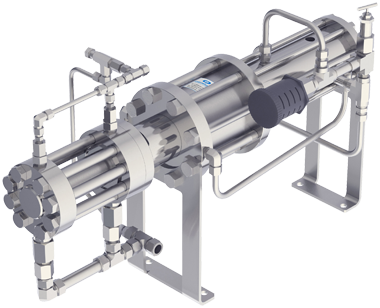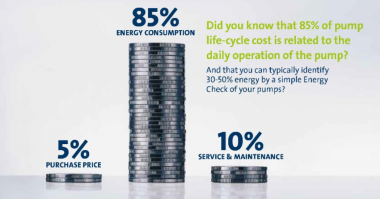Pneumatic systems use pressurized gas or air to move media and when found in industrial applications are commonly powered by compressed inert gases or compressed air. A centrally located compressor is used to power cylinders, motors, and other pneumatic devices, including pumps. These systems are often controlled through either a manual or automatic solenoid valve and can provide a more flexible, lower cost, and safer alternative to electric or gas-powered motors.
Types of Pneumatic Pumps
Pneumatic pumps are often positive displacement pumps that are double-acting with no return spring and can utilize many pressurized gases or fluids as drivers. There are many different types of pneumatic pumps, but some of the most widely known are:
- Pneumatic Diaphragm Pumps (both piston and plunger types) – They use a plunger or piston mechanism to move media through a cylindrical chamber. This mechanism is powered by a pneumatic, electric, hydraulic, or steam drive.
- Pneumatic Liquid Pumps – Used to move liquid.
- Pneumatic Refrigerant Pumps – Used to move refrigerant, usually two stage pumps.
- Pneumatic Test Pumps – These pumps are built and configured to test the effectiveness of a particular pneumatic system.
Pneumatic Pump Applications
Pneumatics pumps are specially designed for demanding oil and gas production applications, along with use in many other industries such as pulp and paper, fertilizer dosing, water treatment, and food processing.
Pneumatic Pump Numbers
- Flow Rate Ranges – 0.005 to 1,175 gallons per hour, or 0.02 to 4,447.37 liters per hour
- Process Pressure Ranges – up to 20,000 psi, or 1380 bar
- Horse Power Ranges – .33 to 10 HP
Pro’s and Con’s of Pneumatic Pumps
Because they use pressurized air to operate, pneumatic pumps can have a lower total cost of ownership when compared to traditional pumps. Other advantages include reduction in chemical waste, reduction in lost production, increased program effectiveness, reduced repair time, reduced energy consumption, and other related reductions in operating expenses.
In the case of pneumatic diaphragm pumps, they can handle many different types of fluids, even those that contain some solid material. The construction of these pumps protects them from piston corrosion and reduces the risk of seal problems.
Advances in Pneumatic Pumps
Blackhawk Technology Company Edge™ Pneumatic Pumps – Used for groundwater and light remediation and landfill pumping, these pumps are competitive with popular airlift models but offer greater power and reliability. The 101 model pumps deeper than airlifts to 281 feet with flow rates of 2 gallons per minute, while the 102 model pumps to 119 feet with flows of 5 gallons per minute.
Almatec CXM Series AODD Pneumatic Pumps – One of the standout benefits of these pumps is they are available with three different sizes with BSP connections and four different sizes with NPT connections. Housing parts are attached with bolts tightened against a diaphragm-sized ring located on each side of the pump. This method allows the pump to transmit the forces of the bolts onto the housing parts evenly.
Sources:
https://en.wikipedia.org/wiki/Pneumatics





Hi i want to know that do u have diaphragm pumps / pneumatic operational pump in PVC , having slow rate of 1000 L/ hr.